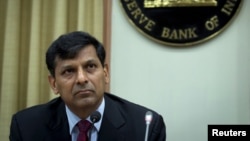India’s Central Bank has cut interest rates to spur investment in the country, which is now the world’s fastest growing major economy. There is more optimism about the Indian economy a year after Prime Minister Narendra Modi took office, but experts remain cautious about the future.
The rate cut of a quarter percentage point announced Tuesday will enable banks to borrow from the Central Bank at 7.25 percent. It is the third cut this year and has been prompted by moderating inflation.
Pointing to many stalled projects, Central Bank governor Raghuram Rajan hopes the rate cut will revive investment.
“We still have very weak investment, investment is very tepid," he said. "We have not seen a strong pick up. In general corporate results have been quite weak also suggesting that final demand is still yet to pick up strongly. Those are the reasons why we feel the economy is still below potential.”
Industry has long complained that high interest rates have dampened not only investment, but also consumer demand, keeping customers away from shopping for homes and automobiles.
Despite those problems, recent data show the country’s economy is performing well.
Last week, government announced India clocked growth of 7.5 percent in the first three months of the year, to outpace China as the world’s fastest growing major economy.
Prime Minister Narendra Modi’s government, which won a strong mandate a year ago on the promise of restoring growth, points to the recent numbers to say that the economy has revived. It is taking credit for restoring business and investor confidence and bringing India back on the global radar.
Analysts like economist Dharmakirti Joshi at rating agency Crisil in Mumbai says there has been a strong turnaround in the past year. But he warns the recent numbers are somewhat deceptive as the economy is still not running at full steam and many challenges remain.
“Government has put up some building blocks that will push growth up over the medium rung, they have tried to improve ease of doing business, they have streamlined quite a few processes, but none of these actually quickly revive demand, and demand is the number one challenge for India," he said. "Unless demand picks up investment cycle is not going to revive.”
Economists say keeping the economy on a fast track will largely depend on pressing ahead with reforms. But some key reforms, such as a land acquisition bill, have been stalled by opposition parties.
Most agree that the huge expectations raised by Modi have been moderated and it will take more time for him to deliver the jobs and “better days” promised during his election campaign.
Among the immediate challenges the government faces is that of a weak monsoon, which is critical for the agriculture sector and rural incomes.
Monsoon rains come from June to September, bringing crucial moisture which sustains two thirds of India’s farming. But on Tuesday, the government cut its monsoon forecast to 88 percent of the long-term average, raising fears of a drought.
But the government’s chief economic adviser, Arvind Subramanian, remains confident that this will not pose a risk to the economy.
“Last year as well the monsoons were not every good, and through with government policy we managed to contain inflation and I think we intend to do that this time, should the monsoon be as bad as some people fear,” he said.
Despite such assurances, the Central Bank sounded a note of caution as it announced the rate cut on Tuesday, saying that a weak monsoon or a rise in global oil prices could push up inflation.







